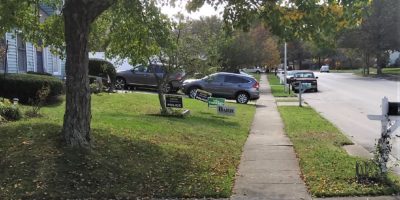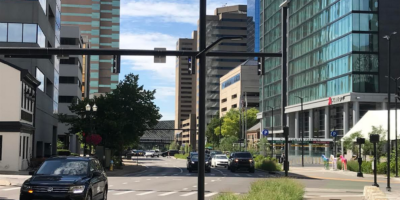By Danny Mayer
What do you get when a state university that operates as if it were a multi-faceted corporation starts sharing notes with an abashedly pro-big business city mayor? In Lexington, Kentucky, thus far you get a privately funded study to set the terms on how much public city money will suck into the state’s flagship public university, the University of Kentucky (UK), so that its quasi-private Athletic Association can fund improvements to a downtown arena used by its men’s basketball team. In Lexington, you staff the study with people holding vested interests in making the project work at all costs. Then you enlarge the area and scale of the project nearly three-fold to 46 city acres, call it an “opportunity zone” and officially christen the territory the Arena, Arts and Entertainment District (AAED).
That committee, the AAED, is slated to report phase one of its findings in early September, according to Tom Eblen writing in the July 31 Lexington Herald Leader. In preparation, here’s how we got here.
How a district gets is born
The Arena, Arts and Entertainment Task Force is the most recent group tasked with overseeing Rupp arena renovations. In the 1990s, as the college negotiated a new lease on Rupp Arena, UK created a study to look into the possibility of relocating the arena to an on-campus location nearby Commonwealth Stadium. Athletic director CM Newton has since acknowledged the study was simply a ploy to get more concessions on athletic association’s Rupp lease. The ploy seems to have worked. After signing a long-term agreement to lease Rupp, the thirty-year old arena promptly received a $40 million facelift in the late 1990s and 2000s.
With the university a decade away from needing to renegotiate its lease, in 2008 UK began angling again for better terms on the site. At that time, the state university lobbied for the London-based sports marketing and branding firm IMG and its subsidiary, International Stadia Group (ISG), to perform a feasibility study. Essentially, the study was to see if it (the private investment firm IMG and its subsidiary ISG) could pay for improvements by assuming a certain private stake in the the Rupp Arena experience.
After this report went belly-up in the 2008 financial crash, the University, forced to slum it once again, return to the public municipal trough. For the past year, they have been met with open arms by new Lexington mayor Jim Gray. The head of a building corporation with a multi-national presence, Gray has a creative-class driven vision that champions using public money to help specific private downtown developments clustered in a narrow area around the city’s Main Street.
The Arena, Arts and Entertainment District, a 46-acre opportunity zone of economically aesthetic parking lots dotted throughout by a convention center, food court, roller derby court and 20,000+ seat arena, is where “town/gown” relations are at right now. The AAED is bounded by “the downtown business district, the fringes of the University of Kentucky, the emerging restaurant and entertainment areas along Manchester and Jefferson streets, and five historic residential neighborhoods.” This location nearby recently proclaimed city hotspots has gotten the area touted as the “biggest development opportunity in modern Lexington history”—Centrepointe on steroids.
Addition by addition
Public conversation on the topic seems to have arrived at four conclusions: (1) that Rupp will either be renovated or re-built; (2) That economics will dictate a Rupp renovation rather than new construction because this route will require less public funds; (3) that any re-do requires the geographic scope of the project to greatly increase, that changes occur across districts and not buildings; and (4) anything done must be bonified first-rate, real world class.
From the University of Kentucky side of things, basketball coach John Calipari, whose $4 million annual salary is provided by the privately funded UK Athletic Association, was the first to play up the vital need for world class. UK Basketball needed to remain a “gold standard” program, he stated. This term, “gold standard,” was later used by UK Athletic Director Mitch Barnhart (salary=$700,000) and UK CEO Lee Todd (salary=$700,000) in reference to any potential changes at Rupp.
On the city side, leaders have used the increased area of the “district” designation to push new urbanist design plans. The key word, municipally, is “design excellence.” Jim Gray has openly called for using city money and leverage to develop the area. The Herald Leader has charged city leaders with creating “something extraordinary to convince the public and its elected representatives that [public money] would be an investment and not an extravagance.”
Meanwhile, most city discussions assume that at least one of the contiguous areas, the recently named Distillery District off Manchester Street, will likewise receive city and state funds for private development of the area. It’s a classic case of addition through addition. The city justifies public money getting spent on un-needed infrastructure upgrades partly on the basis that it’s also giving away public money to private development interests in a contiguous neighborhood.
With the AAED task force yet to release their September report, we cannot yet tally how much public investment it will call for, but traveling one block west to the Distillery District might give an indication.
In his recent city budget proposal, Mayor Jim Gray went to bat for his tough austerity measures—cutting public jobs and funding for social service agencies—to right-size government and decrease city debt. The mayor made a great show, and the media followed right along, of a get-tough veto of what he described as an unnecessary $400,000 bond. The public money was to be used for the construction of 2 disc golf courses and a lacrosse field on public park lands, and a public access ramp for seniors at a planned Seniors Center. Gray stated that he didn’t feel a “Frisbee golf course” was a good investment for the city.
Meanwhile, Emily Hagedorn reports in Kentucky Forward, the same austere city budget issued a $2.2 million bond to pay for infrastructure costs in the Distillery District. Of this amount, $418,000 was authorized the city simply to pay for a feasibility study of the district that abutts the western edge of Rupp’s Arena district. Not a single media source I’ve seen mentioned that bond payment, though several have praised the mayor for his “spread the pain” budget that included the veto of public improvements to park land and disability access for the aged.
Private and public interests
Several prominent investors in the Distillery District, most notably the New Buster’s co-owner Barry McNees, appear as members of the Arena, Arts and Entertainment District task force. Other task force members have relationships, like McNees, that pre-dispose them to benefit disproportionately off increased public investment in the area. Prominent UK Athletics Association backer Luther Deaton (head of Bank One) is on it; so is UK Athletic Director Mitch Barnhart. City developer Dudley Webb, whose vacant lot CentrePointe project four blocks away is asking for $50 million in public city investment on the basis of downtown rejuvenation, has a seat. So does Everette McCorvey, a UK opera professor whose name has appeared in relation to Distillery District projects.
In Mid-April, UK sports beat reporter Jerry Tipton interviewed Faculty Trustee Joe Peek. Peek, a business professor with tenure, confessed his unease with the Rupp proposals. “My concern is that the state, city and university are in bad financial shape, so is it something that we can afford at this time.” Peak’s question is not one Luther Deaton or Mitch Barnhart or Barry McNeese are much interested in considering. They and their specific interests all stand to profit, individually, from publicly funded Rupp renovations. This doesn’t make them inherently bad people (though they may make bad decisions), but it does make them vested people.
It’s notable to me that not a single council person–a publicly elected and accountable official–appears on the 40 person Rupp redevelopment task force Mayor Gray created and charged with setting the terms for city involvement. All that good business of public accountability and my city representatives don’t even have a formal and well-represented position on the crew overseeing the opening stages of a potentially costly Rupp re-design. The question needs to be asked, and often, who will advocate for the larger community interests? Who will say enough, basta?







2 Pingbacks